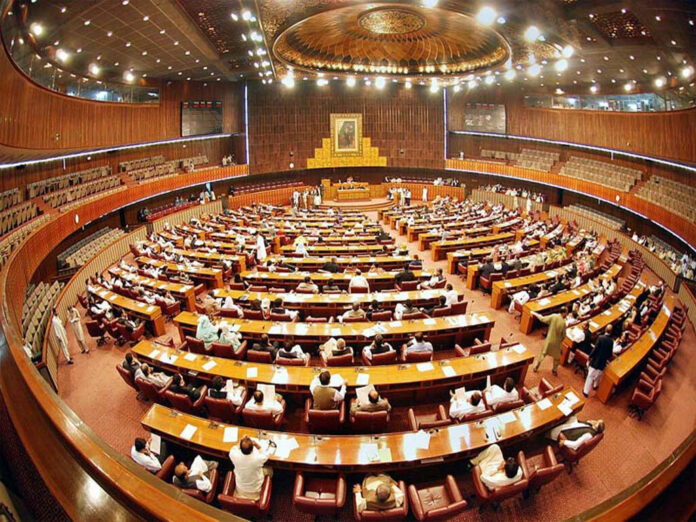AT PENPOINT
The government’s attempt to amend the Constitution may have ground to a halt because it lacked the numbers, but the government and its allies have still to press on with the effort. It seems the numbers game still relies on Maulana Fazlur Rehman’s JUI(F) voting for the amendments, but he has refused so bluntly, that he will only agree by making amendments to the amendments.
True, there is no official text of the amendments released to the public. There is some dispute about whether the versions presented to the PPP and the JUI(F) were the same or not. What has appeared in the media coincided with the government’s sharing the amendments with the PPP and JUIF). It seems that this government caginess was justified from this point of view, but it was not justified from the point of view of keeping the public informed.
These are after all amendments to the Constitution, a document which says that ‘We the people of Pakistan have enacted for ourselves through our chosen representatives’, a very direct echo of the preamble to the US Constitution, which is the model of all written Constitutions since.
The implication is that since it is an overarching document, amendments are not only to be made carefully, but part of that process of care is that they be given full publicity before they are passed, so that they are considered from all sorts of angles.
Another issue that arises is the role of MNAs and Senators. It is to be noted that all party leaders seem to view them as sheep or cattle, and themselves as herdsmen. That is to an extent how far the present interpretation of the Constitution’s anti-defection clause, Article 63A, does regard them.
One view of elected representatives is that they are purely party representatives. This can only be propounded under a party-list system. Another view is that they have been delegated by their constituency’s voters to deal with all matters in the Assembly as they see fit. The third view is that they are mere representatives, who have to do as their electors wish. In the current amendments situation, there does not seem to have been any consultation with constituents. MPs have taken it upon themselves to vote as they see fit, and have decided to do whatever their party leader tells them.
As the amendments deal with the judiciary, one would have expected lawyers to have been in the forefront of the lobbying effort, as lawyers. So far, lawyers’ efforts have been purely partisan, which has not been very informative about what the amendments actually mean.
One point which has been raised is how the opposition (basically the PTI) could challenge the Amendment. First, it could challenge it on procedural grounds, such as whether the Cabinet accorded approval or not, or whether the number of members passing the amendment were complete or not, or whether the President had duly given assent.
However, there is also the possibility of the Supreme Court being asked to invoke the Basic Structure Doctrine, and strike down the amendment itself. The legislature is supposed to determine the text of the Constitution, and the Supreme Court to interpret it. The Basic Structure Doctrine was evolved over decades in India, and postulates that a supreme court has the right to examine any constitutional amendment and to strike it down if it was found to conflict with the ‘basic structure’ of the Constitution. There is no text which states what that basic structure is, and if the Indian Supreme Court is to be relied on, the judges merely make it up.
Well, not quite, The Indian Supreme Court has mentioned 21 basic structures, which it says Parliament cannot change. It thus allocates the Constituent Assembly, the first Parliament of independent India, a special status. However, it also must be noted that Parliament is itself a creation of the Constitution, and thus cannot amend its basic structure. One of the basic structures identified has been the independence of the judiciary.
Indeed, in the leading Pakistani case on the issue, the Supreme Court was approving of the doctrine, though it did not strike down the 21st Amendment, which had been challenged. It may be noted that the issue involved appointments to the judiciary, and the parliamentary judicial committee’s relationship to the Judicial Committee. The Amendment was passed because the Court had suggested certain amendments to the law, but had not struck down the impugned amendment, leaving it to Parliament to make the requisite changes. It is worth noting that the case was heard by a 17-member Full Court Bench, of which a junior member was Mr Justice Faez Issa, who concurred with the judgement authored by Chief Justice Nasirul Mulk, who became in 2018 caretaker Prime Minister.
The Basic Structure Doctrine makes a certain kind of sense, but it basically has no grundnorm, no document on which a court can rely while applying it. The basic problem seems to be that it seems best applicable to an unwritten Constitution, like the British, but has been developed around a written, the Indian. If Pakistan’s Supreme Court applies it to strike down a constitutional amendment, it is to be hoped that it sheds the sort of light the doctrine needs.
The entire tenor of Mr Justice Isa’s career has been towards judicial independence. At the same time, as he himself recently remarked in September, the legislature’s Acts should not be overturned lightly. It should be noted that the Supreme Court of India had struck down the 39th Amendment in the matter of Prime Minister Indira Gandhi’s disqualification as MP, because it was fighting off an attempt to convert the Constitution into a means of perpetuating Mrs Gandhi in office.
The Basic Structure Doctrine is akin to an atomic weapon, or rather a hydrogen bomb. It is not invoked lightly, but it may become necessary if the Supreme Court is to play its role as the guardian of the Constitution. However, it is also the final interpreter of the Constitution. What apart, or above, the Constitution exists? One is reminded irresistibly of the old world maps of centuries ago, where would be written over certain areas ‘Hic sunt leones’, which were later translated as ‘Here There Be Tigers’. So far, Pakistani courts have been interpreting actions in the light of laws, and laws in the light of the Constitution. It has been striking down laws as violating the Constitution? What can a constitutional amendment violate?
The Objectives Resolution has been made a ‘substantive’ part of the Constitution, and has been suggested as providing the basic structure. However, in the Hakeem Khan case, the Supreme Court has already ruled that, like the Principles of Policy, the contents represent aspirations, but are not justiciable. That would again leave the Supreme Court to carry out any interpretations. But what external criterion would they have to base them on?
The doctrine also has the disadvantage of keeping the Constitution static. To commit to it would mean making any changes to the Constitution depending on the will of the Supreme Court. The composition of the Supreme Court is essentially unpredictable, because it depends on a selection for the various high courts from amongst members of the bar and the subordinate judiciary. After that, it becomes Buggins’ Turn, with elevations to the Supreme Court depending on seniority, with no comment on competence.
What exactly does independence of the judiciary mean? It means the freedom of judges to decide matters placed before them according to the law and Constitution. Anything the Supreme Court feels infringes on this, would be deemed to constitute an attack on judicial independence. Thus if one assumes the Supreme Court is guided by the Objectives Resolution to place independence of judiciary as a basic structure, it is free to decide what is that independence.
The Basic Structure Doctrine makes a certain kind of sense, but it basically has no grundnorm, no document on which a court can rely while applying it. The basic problem seems to be that it seems best applicable to an unwritten Constitution, like the British, but has been developed around a written, the Indian. If Pakistan’s Supreme Court applies it to strike down a constitutional amendment, it is to be hoped that it sheds the sort of light the doctrine needs.























